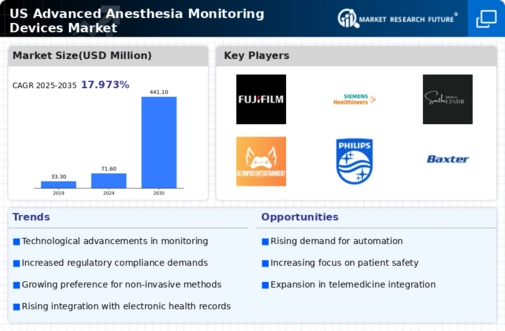Regulatory Support and Standards
The advance anesthesia-monitoring-devices market benefits from robust regulatory support and established standards that ensure device safety and efficacy. Regulatory bodies in the US, such as the FDA, have implemented stringent guidelines for the approval and monitoring of anesthesia devices. This regulatory framework not only enhances consumer confidence but also encourages manufacturers to innovate and improve their products. Compliance with these regulations is essential for market players, as it directly impacts their ability to compete effectively. The presence of clear standards fosters a competitive environment, driving advancements in technology and design. Consequently, the market is expected to expand, with projections indicating a growth rate of around 7% as manufacturers align their products with regulatory expectations.
Focus on Enhanced Training and Education
The advance anesthesia-monitoring-devices market is also being propelled by a heightened focus on training and education for healthcare professionals. As the complexity of anesthesia monitoring devices increases, there is a corresponding need for comprehensive training programs to ensure that medical staff are proficient in their use. Educational initiatives aimed at anesthesiologists and surgical teams are essential for maximizing the benefits of advanced monitoring technologies. This emphasis on training not only improves patient safety but also enhances the overall effectiveness of anesthesia management. As healthcare institutions invest in training programs, the market is likely to see a growth rate of around 4% as the workforce becomes more adept at utilizing advanced monitoring devices.
Increasing Demand for Patient-Centric Care
The advance anesthesia-monitoring-devices market is driven by a growing emphasis on patient-centric care. Healthcare providers are increasingly focusing on personalized treatment plans that cater to individual patient needs. This shift is prompting the adoption of advanced monitoring devices that provide comprehensive data on patient vitals and responses to anesthesia. Enhanced monitoring capabilities allow for tailored anesthesia management, which can lead to improved recovery times and reduced complications. As a result, the market is witnessing a notable increase in demand for devices that facilitate this level of personalized care. Market analysts project that the patient-centric approach could contribute to a market growth of approximately 6% annually, as healthcare systems prioritize patient satisfaction and safety.
Technological Advancements in Monitoring Devices
The advance anesthesia-monitoring-devices market is experiencing a surge due to rapid technological advancements. Innovations such as real-time data analytics, artificial intelligence, and machine learning are enhancing the capabilities of monitoring devices. These technologies allow for more accurate patient assessments and timely interventions, which are crucial during surgical procedures. The integration of advanced sensors and connectivity features enables seamless data transfer, improving the overall efficiency of anesthesia management. As hospitals and surgical centers increasingly adopt these technologies, the market is projected to grow significantly, with estimates suggesting a compound annual growth rate (CAGR) of around 8% over the next few years. This growth reflects the industry's commitment to enhancing patient outcomes and operational efficiency through advanced monitoring solutions.
Rising Surgical Procedures and Anesthesia Utilization
The advance anesthesia-monitoring-devices market is significantly influenced by the increasing number of surgical procedures performed annually. As the population ages and the prevalence of chronic diseases rises, the demand for surgical interventions is expected to grow. This trend necessitates the use of advanced anesthesia-monitoring devices to ensure patient safety and effective anesthesia management during surgeries. According to recent data, the number of surgical procedures in the US is projected to increase by approximately 5% annually, further driving the need for sophisticated monitoring solutions. This growing utilization of anesthesia in surgical settings is likely to propel the market forward, with estimates suggesting a potential market expansion of around 9% in the coming years.

















Leave a Comment